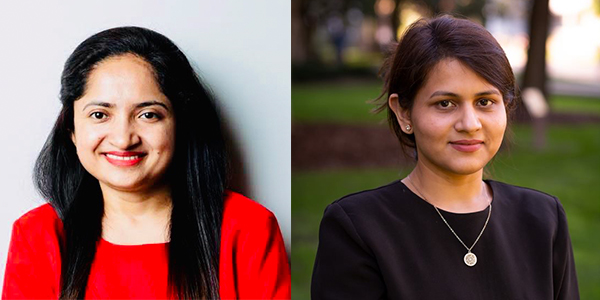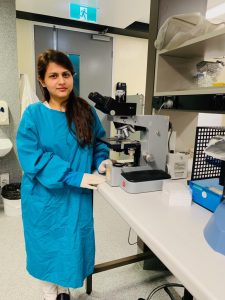1:30min

Sidra Sarwat, left, and Rabia Mobeen
By Helen Carter
Journalist
Two optometrists from Pakistan studying their PhDs at UNSW are the recipients of prestigious awards from the American Academy of Optometry Foundation.
They have received the awards for their research on contact lens wear in young people, and optimised quantum dots which should contribute to understanding drug delivery methods for dry eye.
Rabia Mobeen said her research on contact lenses in youth would provide fundamental information on the ocular immune response and provide insights into methods of improving the safety of contact lens-related myopia control treatment.
Her colleague Sidra Sarwat has developed an optical system for detection of quantum dots which is likely to contribute to the understanding of effective drug delivery methods for dry eye disease.
Sidra, a first-year PhD candidate at the School of Optometry and Vision Science, University of New South Wales, is the American Academy of Optometry Foundation’s 2020 Joe and Janet Barr Early Career Cornea and Contact Lens Research Award recipient.
Rabia is one of 11 recipients of the foundation’s 2020-2021 William C. Ezell Fellowships. She will receive the Rod Tahran/Essilor Ezell Fellowship and is the first Ezell fellow from Pakistan in the 71-year-history of over 430 Ezell Fellowships being awarded.
Sidra’s project is entitled, “In Vivo Labelling and Bioimaging of the Tear Film Using Silicon Quantum Dots.” The foundation said she presented an impressive resume of experience in clinical research, volunteer service and lecture presentation.
She received a travel fellowship from the Academy in 2018 during her Master of Optometry at UNSW and the PhD project is a continuation of her Master’s work.
Optical system for detecting quantum dots
‘My PhD project involves application of optimised quantum dots in rabbits and monitoring turnover of tear film using fluorescence pattern of quantum dots,’ she said. ‘It involves synthesis of quantum dots (nanoparticles), characterisation of their fluorescence pattern characteristics and understanding their performance in an animal model.
‘This is likely to contribute to the understanding of effective drug delivery methods for dry eye disease.
‘I have successfully developed an optical system for detection of quantum dots, characterised the fluorescence characteristics of metal-doped quantum dots, studied their performance in artificial tears and established their cytotoxicity to human corneal epithelial cells in vitro.
‘I have also published an invited review article in Current Eye Research highlighting possible applications of novel quantum dots in ophthalmology. Two further manuscripts are in progress describing the feasibility of quantum dots to monitor tear film layers and cytotoxicity of quantum dots on ocular surface cells including human corneal epithelial cells.
‘I have presented my research at domestic and international conferences and received a University International Postgraduate Award to complete my PhD at UNSW.’

Rabia Mobeen
Effect of youth and contact lens wear on cornea
In 2019 Rabia was a recipient of the foundation’s Barr award.
The Ezell fellowship is not just related to her research but also observes her overall contribution to optometry including leadership qualities and contributions towards optometry education, teaching and clinical services.
Rabia is researching the effect of youth and contact lens wear on the inflammatory status of the cornea. The project aims to compare the ocular surface immune response to contact lens wear in youth.
She is assessing changes in corneal epithelial dendritic cell density, morphology and distribution using in vivo confocal microscopy and their relationships with corneal nerves and tear inflammatory mediators.
‘This study will not only provide fundamental information on the ocular immune response but will provide insights into methods of improving the safety of contact lens-related myopia control treatment,’ Rabia said.
‘There are two types of lenses used for myopia control – orthokeratology lenses and soft contact lenses.
Ortho-k suppresses immune response
‘Our research has found that orthokeratology lenses suppress immune response while soft contact lenses enhance immune response.
‘This novel finding is crucial in our efforts to improve the safety of contact lens wear. It will also help practitioners to apply more effective, safe and evidence-based contact-lens based myopia control treatments, with good compliance rates.’
The American Academy of Optometry Foundation is the philanthropic arm of the American Academy of Optometry. It provides financial support for optometric research and vision and eye health education to improve patient clinical care.
Its Ezell fellowship program is named after the founding president of the foundation while the Barr award honours mentor and optometry role model Dr Joseph Barr.
Tagged as: Awards - honours - grants-bursaries, Contact lenses, Dry eye, International, Myopia, Patient management, Students, Universities